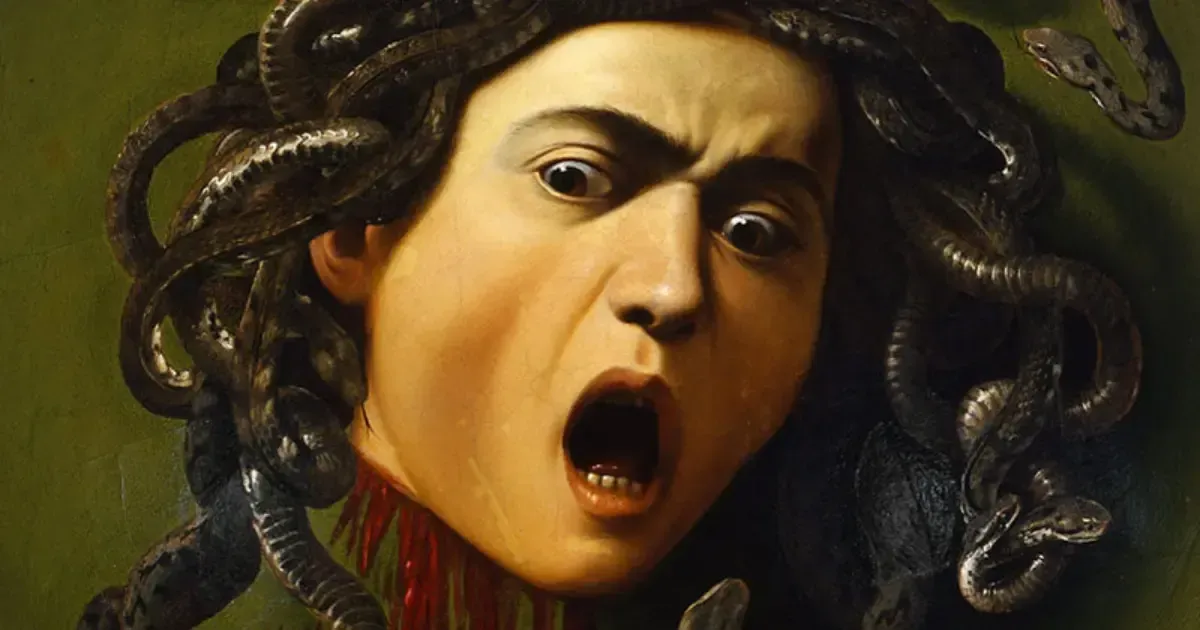
Shield with the Head of Medusa by Caravaggio
Shield with the Head of Medusa by Caravaggio
Shield with the Head of Medusa by Caravaggio stands as a remarkable example of how Italian artists, influenced by Leonardo da Vinci, showcased their mastery. Whether intentionally or not, no Italian artist who studied da Vinci could avoid his influence. Many of the later artists, notably Caravaggio, clearly exhibit this in their works. One such example is Caravaggio’s “Medusa,” commissioned by Cardinal del Monte, a Medici family agent from Rome. Vasari also claimed that da Vinci had produced a Medusa shield for the Grand Duke’s collection in a 1568 paper. If this is accurate, del Monte most certainly knew about it and pushed the young Caravaggio into masterful performance.
Caravaggio created two renditions of the “Head of Medusa.” First finished in 1596; second, most likely in 1597 or 1598. Signed “Michel A F” (Michel Angelo Fecit), the first version, called “Murtula,” is 48×55 cm and named for the poet who penned about it. Now housed in a private collection, this version was unearthed in Caravaggio’s workshop following his death. Slightly bigger at 60×55 cm, the second version is unsigned and kept at the Uffizi Gallery in Florence.
Executed in 1598, the second “Head of Medusa,” commissioned as a ceremonial shield by Cardinal Francesco Maria del Monte following his view of the first version at Caravaggio’s studio, The commission sought to represent the bravery of Tuscany’s Grand Duke in conquering his adversaries. Caravaggio borrowed from the Greek tale of Medusa, a woman with snakes for hair who could transform onlookers to stone.
One of the Gorgon monsters in Greek mythology, Medusa was renowned for her terrible looks and power to petrify anybody who came into her sight. Medusa was unusual among her sisters, Stheno and Euryale, in that she was mortal, even as Gorgons are usually characterized as having hair made of living snakes and a terrible appearance. The tale goes that Perseus killed Medusa by keeping her head as a weapon since it kept its petrifying power and by using a mirrored shield to evade her stare, therefore decapitating her.
Caravaggio, in his view, modeled Medusa’s face on his own, therefore shielding himself from Medusa’s lethal stare. He had to stare at his reflection, reflecting Perseus’s use of the shield to view Medusa, to paint the shield. Medusa’s head is shown as severed, however Caravaggio shows her as still conscious. Her wide-open mouth lets out a silent scream, and her startled eyes and wrinkled brow suggest a sense of incredulity, as though she thought she was unbeatable right up until her death. Medusa’s stare does not directly face the observer, so she passes the power of hers to us and emphasizes her vulnerability in her last hours.
With his technical mastery, Caravaggio’s “Medusa” makes a convex surface seem concave and gives the impression that Medusa’s head stretches outward. This deft treatment of perspective and emotional intensity highlights Caravaggio’s creative approach and his capacity to use his work to portray dramatic stories.
TOP SELLING UFFIZI TICKETS
Here’s your chance to get your Uffizi Gallery Tickets! Simply choose from one of our best selling and most popular Uffizi Tickets.
Also See
